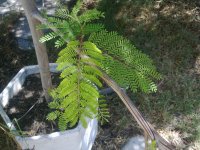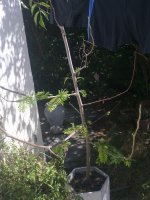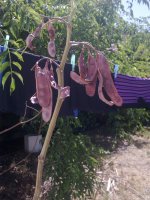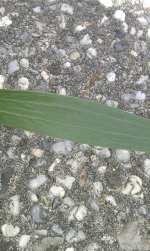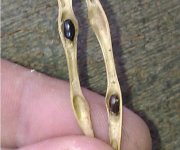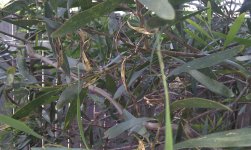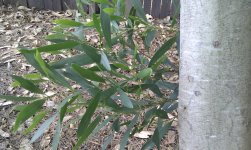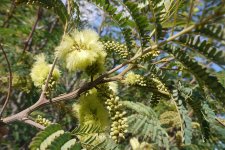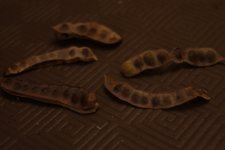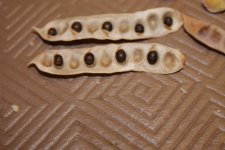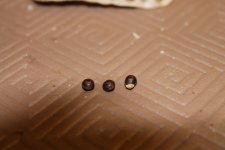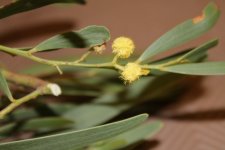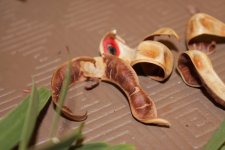-
Members of the previous forum can retrieve their temporary password here, (login and check your PM).
You are using an out of date browser. It may not display this or other websites correctly.
You should upgrade or use an alternative browser.
You should upgrade or use an alternative browser.
Botany Acacia and Mimosa Identification Thread
- Thread starter endlessness
- Start date
Growing logs with advice and results.
Migrated topic.
Unik... thats not an acacia.. remember that the acacia is the wattle 
Blackandblue
Rising Star
Hi Guys, it's a new year so I just thought I'd give a friendly second ask if somebody can have a look at the set of photos I posted on page 12 and give me an idea of what they are/might be (Acacia and Mimosa Identification Thread - Collaborative Research Project - Welcome to the DMT-Nexus)
Thanks once again
Thanks once again
Parshvik Chintan wrote:
 ..and acacian..
..and acacian..
cave paintings..that's really interesting..looks a bit like melanoxylon, but it isn't..you got me there for now..i'll have a think..
& changalvia..i'd say you've got a Poinciana there..
.
..well said Parshvikunik wrote:
Is this an acacia? Location is North Sydney. Thanks!
i am no expert, by any means. but i am almost positive those are leaves, not phyllodes.
cave paintings..that's really interesting..looks a bit like melanoxylon, but it isn't..you got me there for now..i'll have a think..
& changalvia..i'd say you've got a Poinciana there..
.
The number of leaflets and constrictions on the fruit aren't what I'd anticipate on rigidula. I've seen it be incredibly variable in appearance though so I'll dig a bit and come back to this.
---ooo0ooo---
Rising Star
Hi,
Four or five years ago we had some plumbing work done at the back of the holiday house, (Shoalhaven area of NSW south coast), and a year later I noticed some acacias had popped up from the damaged earth.
They've been growing nicely in the years since, and I was amazed to see how big they'd got over the last twelve months. I'm guessing Acacia longifolia - can anyone confirm? Photos taken around New Year's.
Thanks!
 O.
O.
Four or five years ago we had some plumbing work done at the back of the holiday house, (Shoalhaven area of NSW south coast), and a year later I noticed some acacias had popped up from the damaged earth.
They've been growing nicely in the years since, and I was amazed to see how big they'd got over the last twelve months. I'm guessing Acacia longifolia - can anyone confirm? Photos taken around New Year's.
Thanks!
Attachments
greedings ,i could use some support here,Swim found this acacia in his area, he has compare it with some google images and seems to be acacia mearnsii but cant tell for sure ,he has alrdy extracted from MHRB in the past.How safe is it to test this extraction?

Attachments
mn1k that actually isn't an acacia in that photo I believe it is Paraserianthes Lophantha
..yes acacian's right, not an acacia..
i really recommend people spend a bit of time looking a photos of species, trying to read acacia books, if they really want to get the most out of this thread..
Acacias are really more about Acacias than dmt! although they are linked..
ooo0ooo..that does look like A. longifolia...the straightness of the pod and cream aril are indicative of possible tryptamine traits.. (as are paler or denser flower) ..would've liked to have seen the flowers..
.
i really recommend people spend a bit of time looking a photos of species, trying to read acacia books, if they really want to get the most out of this thread..
Acacias are really more about Acacias than dmt! although they are linked..
ooo0ooo..that does look like A. longifolia...the straightness of the pod and cream aril are indicative of possible tryptamine traits.. (as are paler or denser flower) ..would've liked to have seen the flowers..
.
---ooo0ooo---
Rising Star
Thanks nen - I appreciate the response!
 0.
0.
Would someone be able to help me out with these two?
The seed pods from the first one I don't recognize; and the second I couldn't find any sign of flowers or seed pods but the phyllodes (pretty they are phyllodes anyways) are serrated and that's new to me too.



----------------------------------------------------------


The seed pods from the first one I don't recognize; and the second I couldn't find any sign of flowers or seed pods but the phyllodes (pretty they are phyllodes anyways) are serrated and that's new to me too.



----------------------------------------------------------


^..Snurry, giving the area/region helps speed up ID..the first i would say is in the Acacia aulacocarpa group which also includes A. crassicarpa, A. lamprocarpa , A. midgleyi and the New Guinean A. peregrina..
the second, with the serrated leaves, are i think leaves, and not an acacia..
.
the second, with the serrated leaves, are i think leaves, and not an acacia..
.
Sorry bout that. Richmond area of the Far North Coast.
I thought that might be the case with the second one. The leaves are a lot more delicate than all the acacia's I've seen.
I could only find a A. leptocarpa and the seed pods don't seem to match.
The A. midgleyi seed pods look pretty good, but a bit more twisted. And WWW says they're only in the NT.
The A. crassicarpa looks like a good match though.

It looks just like that, but young.a
I thought that might be the case with the second one. The leaves are a lot more delicate than all the acacia's I've seen.
I could only find a A. leptocarpa and the seed pods don't seem to match.
The A. midgleyi seed pods look pretty good, but a bit more twisted. And WWW says they're only in the NT.
The A. crassicarpa looks like a good match though.

It looks just like that, but young.a
^..yeah i'll ponder it more..it's a real interesting looking one Snurry..
Back with more! 
nen, if it helps with the last one I'm fairly certain it's been planted by a person so it could be from a species not known in my area.




That first one interests me a lot. I thought those type of seed pods were only on bottlebrushes but the flowers don't look anything like a bottlebrush (by the way, any info regarding any active alkaloid content in the common red Callistemon?) so I'm not sure what it could be.


The flowers on this second one remind me of melanoxylon but the flower pods seem to be concentrated before the phyllodes, not spread throughout.

I'm not sure if anyone will be able to help with this 3rd shot.
There is a fair few acacia's around like this one. They aren't bottlebrushes, and none of them are showing any signs of flowering this time of year. The tree is a paperbark though, so that puts me off thinking it's an acacia, but I'm not well versed by any means.
These next ones are just for fun if anyone can identify, I'd like to know what they are every time I go past them.

This looks a lot like the bottle brushes around the area except though those red flowering ends seem to be unique to that tree.
I'm unsure if these are acacia's. Apologies if they aren't but the leaf type intrigued me.


---


---


Also, I was going to ask this in the extraction workplace but it won't let me reply.
As far as alkaloid content I heard it was best to sun dry phyllodes for up to 3 months for best results. Would there really be much of a difference between a box of phyllodes dried in under a week, compared to 3 months?
nen, if it helps with the last one I'm fairly certain it's been planted by a person so it could be from a species not known in my area.




That first one interests me a lot. I thought those type of seed pods were only on bottlebrushes but the flowers don't look anything like a bottlebrush (by the way, any info regarding any active alkaloid content in the common red Callistemon?) so I'm not sure what it could be.


The flowers on this second one remind me of melanoxylon but the flower pods seem to be concentrated before the phyllodes, not spread throughout.

I'm not sure if anyone will be able to help with this 3rd shot.
There is a fair few acacia's around like this one. They aren't bottlebrushes, and none of them are showing any signs of flowering this time of year. The tree is a paperbark though, so that puts me off thinking it's an acacia, but I'm not well versed by any means.
These next ones are just for fun if anyone can identify, I'd like to know what they are every time I go past them.

This looks a lot like the bottle brushes around the area except though those red flowering ends seem to be unique to that tree.
I'm unsure if these are acacia's. Apologies if they aren't but the leaf type intrigued me.


---


---


Also, I was going to ask this in the extraction workplace but it won't let me reply.
As far as alkaloid content I heard it was best to sun dry phyllodes for up to 3 months for best results. Would there really be much of a difference between a box of phyllodes dried in under a week, compared to 3 months?
yeah and diphylla has much shorter and broader phyllodes... i doubt that would be. diphylla is very close in appearance to mangium
hahaha so what the difference between phyllodes and just thick leaves cause I'll be stuffed if I can tell the difference.
But I'd say a gum tree was an acacia if I didn't already know.
That second one you're talking about has a menthol/eucalypt sort of smell. Not real strong, but it's there.
But I'd say a gum tree was an acacia if I didn't already know.
That second one you're talking about has a menthol/eucalypt sort of smell. Not real strong, but it's there.
The Meddling Monk
Rising Star
Its probably better to familiarise with well known acacias before going out and trying to identify lots of plants. It isn't as straightforward as just going out in search of acacias randomly and expecting to find DMT. It's not a fast track option getting to know acacias. Botanical gardens a good place to start.
shanedudddy2
Rising Star
Hi guys,
Got 2 suspects here,
1) unsure if Victoriae or Murrayana, but got seed and seed pods this time.
The seed colouring and location specifics, make me think it would have to be Victoriae, but failed tests a few months ago :/
2) almost sure it's Cyclops, but hope for a confirmation before I try another extraction *crosses fingers!*
Tasted considerably more bitter when I chewed it (going on nen888's tips) than other leaves.
Got 2 suspects here,
1) unsure if Victoriae or Murrayana, but got seed and seed pods this time.
The seed colouring and location specifics, make me think it would have to be Victoriae, but failed tests a few months ago :/
2) almost sure it's Cyclops, but hope for a confirmation before I try another extraction *crosses fingers!*
Tasted considerably more bitter when I chewed it (going on nen888's tips) than other leaves.
Attachments
Similar threads
- Replies
- 4
- Views
- 98
- Replies
- 0
- Views
- 154
- Replies
- 6
- Views
- 718
- Replies
- 3
- Views
- 596

